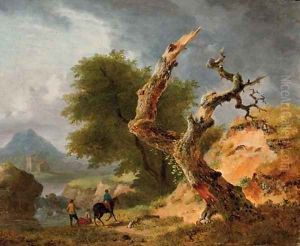Jean Louis Demarne, Called Demarnette Paintings
Jean Louis Demarne, also known as Jean Louis Demarnette, was a French painter born on November 26, 1744, in Brussels, which at the time was part of the Austrian Netherlands. He is most prominently known for his landscapes and scenes depicting rural life, which reflect the aesthetic transition from Rococo to Neoclassicism and also incorporate elements of the emerging Romantic movement.
Demarne initially trained under his father, who was a carriage painter, before moving to Paris to further his education in the arts. In Paris, he became a student of Gabriel Briard and was influenced by the works of the Dutch and Flemish schools, as well as by French artists such as Claude Joseph Vernet. Demarne's paintings often showcase pastoral scenes that include animals and peasants, with a focus on naturalistic details and the harmonious interplay of light and color.
Although not as widely recognized as some of his contemporaries, Demarne's work was appreciated in his time, and he exhibited at the prestigious Paris Salon on several occasions. His works can be found in various museums and collections across Europe. Demarne lived through a tumultuous period marked by the French Revolution and Napoleonic Wars, events that undoubtedly impacted the cultural landscape of his era.
Jean Louis Demarne continued to paint and contribute to the art world until his death on January 28, 1829, in Paris. He left behind a legacy of bucolic imagery that captures the simplicity and charm of rural French life in the late 18th and early 19th centuries.
